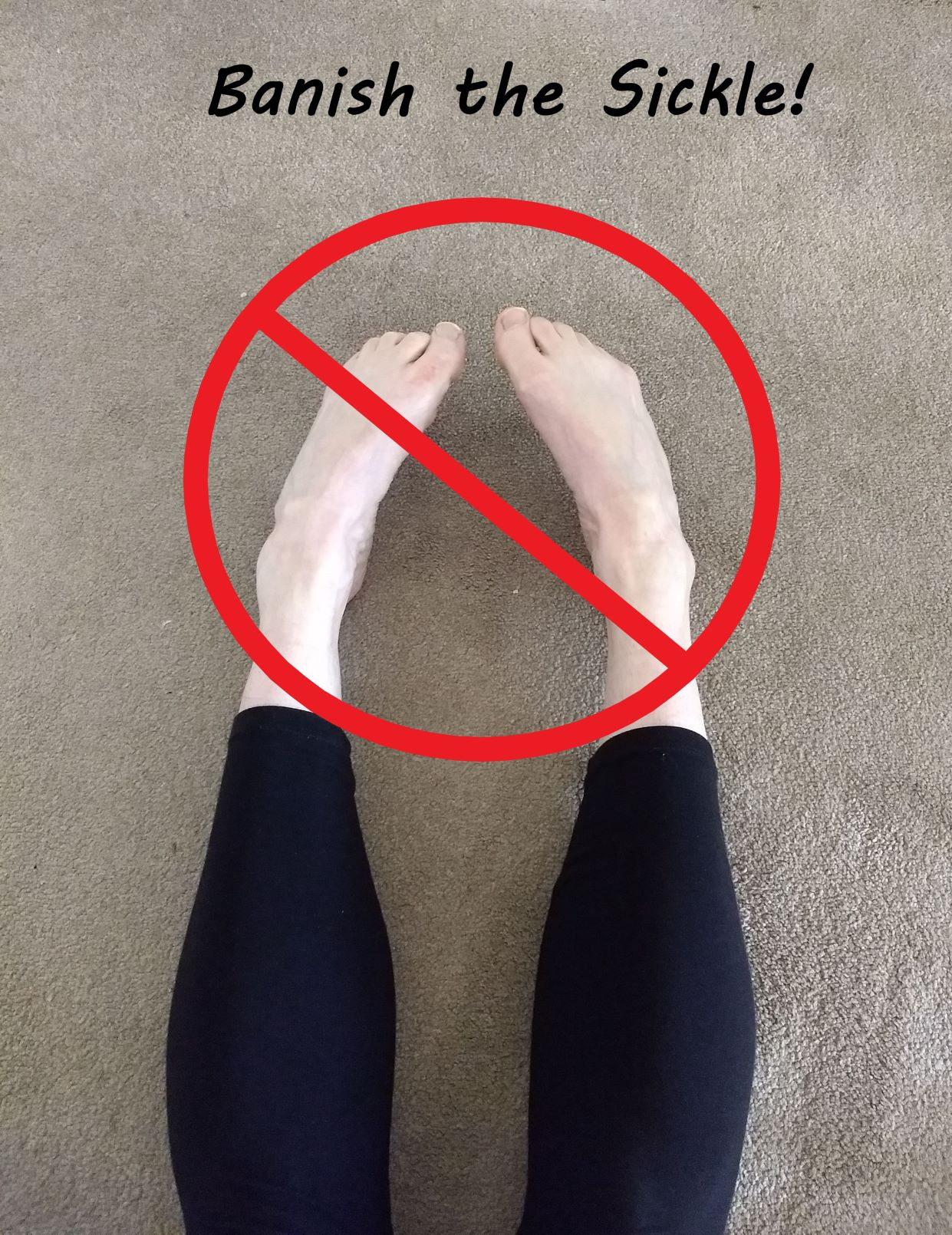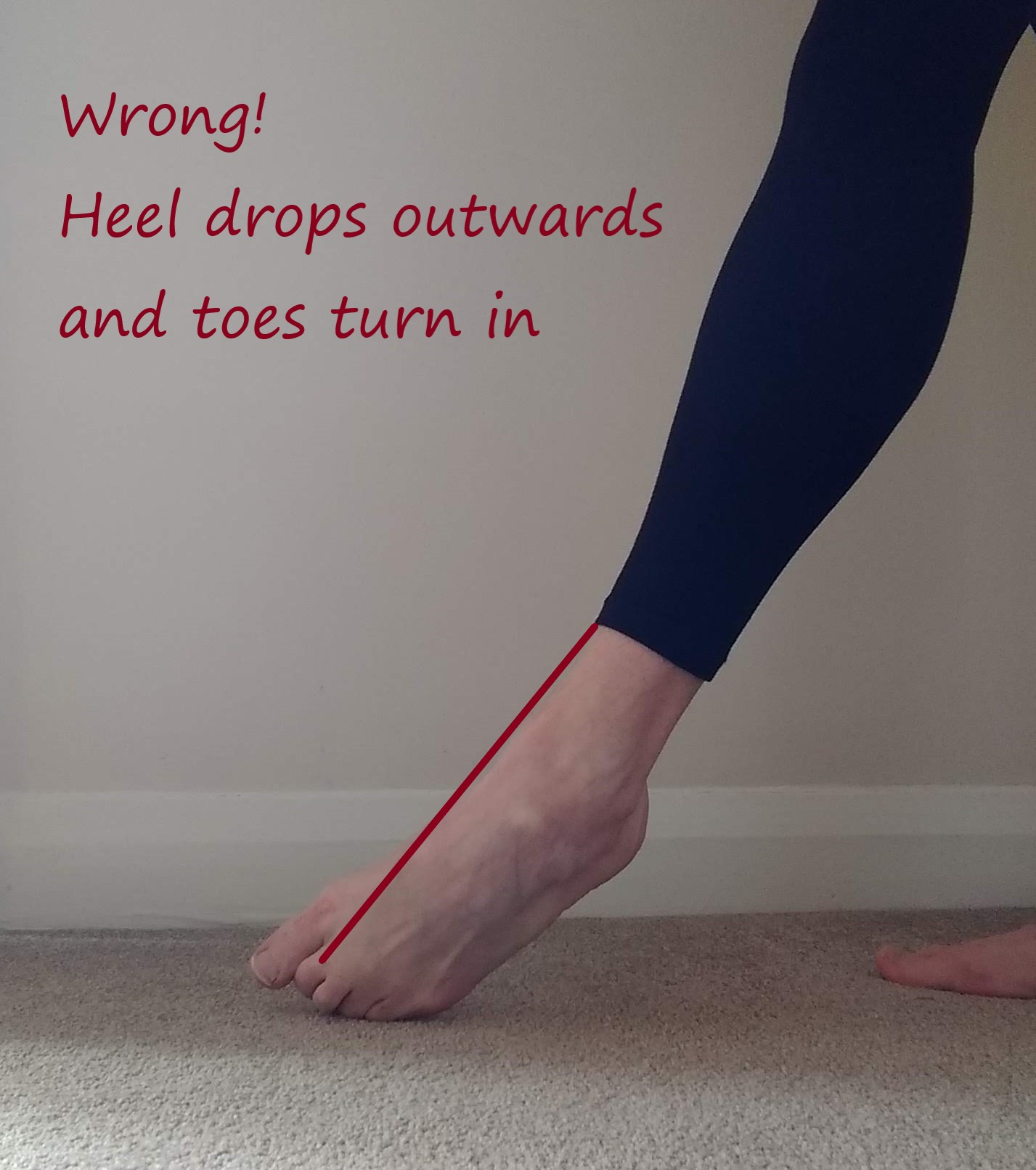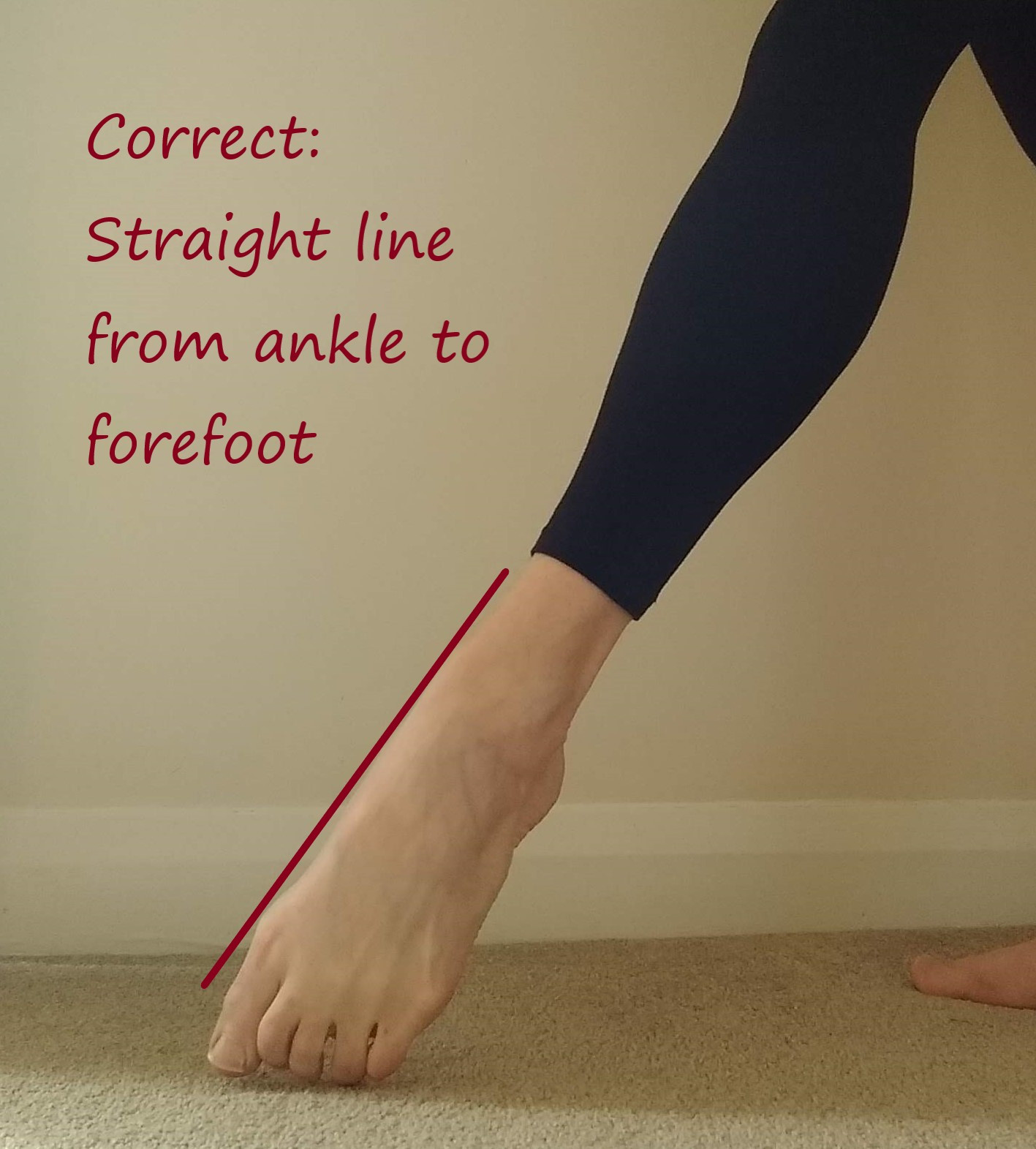In the pursuit of elegant lines and flawless technique, dancers often encounter and must overcome various physical challenges. One common issue, particularly for students striving to enhance their point work, is “sickled feet.” This occurs when, in an attempt to point the foot further, the ankle rolls outward, causing the foot to turn inward. While dancers aim for aesthetically pleasing lines, sickling detracts from this and, more importantly, poses a significant risk of injury.
From a physiotherapy and injury prevention perspective, sickling greatly increases the likelihood of ankle injuries, especially in demi-pointe positions and during pointe work. The outward turning of the ankle makes it vulnerable to collapsing, potentially leading to painful ankle sprains. Understanding and correcting sickled feet is crucial for every dancer’s health and progress.
 Dancer demonstrating sickled foot in ballet position, highlighting incorrect ankle alignment and inward turning of the foot.
Dancer demonstrating sickled foot in ballet position, highlighting incorrect ankle alignment and inward turning of the foot.
What Exactly is a Correct Foot Position in Dance?
Defining the “correct” foot position can vary slightly depending on individual foot shape. However, the general principle involves achieving a straight line from the inside of your ankle down to your forefoot. Ideally, your big toe should align with this line or be positioned just slightly inward. This alignment ensures proper balance, strength utilization, and minimizes stress on the ankle joint.
Visualizing this straight line is key to understanding and correcting sickling. It’s about maintaining integrity in the ankle joint rather than forcing the foot into an extreme point that compromises alignment and safety.
 Close-up of a dancer's foot in tendu position demonstrating a sickled foot with ankle rolling outwards and foot turning inwards.
Close-up of a dancer's foot in tendu position demonstrating a sickled foot with ankle rolling outwards and foot turning inwards.
 Image showing a dancer's foot correctly positioned in tendu, demonstrating a straight line from the ankle to the forefoot and proper alignment.
Image showing a dancer's foot correctly positioned in tendu, demonstrating a straight line from the ankle to the forefoot and proper alignment.
Unpacking the Causes of Sickled Feet in Dance
Several factors contribute to the development of sickled feet among dancers. Identifying these causes is the first step towards effective correction.
Muscle Weakness: A primary culprit is weakness in the muscles of the foot and ankle, particularly the peroneal muscles located on the outside of the ankle. These muscles play a vital role in stabilizing the ankle and preventing it from rolling outward. Insufficient strength in these muscles makes dancers more prone to sickling, especially when pushing for a greater point range.
Limited Flexibility: Dancers with restricted foot and ankle flexibility may also sickle as a compensatory mechanism. The foot and ankle naturally possess a greater range of motion when turned inward. Therefore, dancers may unconsciously sickle their feet to achieve the desired point, especially if their outward range is limited.
Motor Control and Habit: Poor motor control, or simply ingrained bad habits, can significantly contribute to sickling. If a dancer repeatedly practices pointing the foot with incorrect alignment, this faulty movement pattern can become habitual and difficult to break.
Anatomy and Genetics: Individual anatomical variations and genetic predispositions can also play a role. The inherent structure of a dancer’s foot and ankle can influence their natural range of motion and susceptibility to sickling.
Banish the Sickle: Strategies for Correction
Overcoming sickled feet requires a two-pronged approach: strengthening the relevant muscles and developing improved motor control.
Strengthening the Foot and Ankle: Focusing on building strength in the muscles on the outside of the ankle, specifically the peroneal muscles, is paramount. Targeted exercises can effectively strengthen these muscles, enhancing ankle stability and reducing the tendency to sickle.
Developing Motor Control: Alongside strength training, cultivating good motor control is essential. This involves consciously practicing correct foot and ankle alignment during various dance movements, such as pointing the foot and rising to demi-pointe. Consistent practice reinforces the correct muscle engagement and neural pathways, gradually making the correct position more natural and subconscious. This mindful repetition is key to retraining the body and establishing healthy movement patterns.
Importantly, improving strength and motor control is not only crucial for correcting sickled feet but also represents the safest and most functional way to enhance foot flexibility. This approach is far more beneficial and safer than relying on passive stretching devices that can potentially force the foot into unnatural positions.
Addressing the “Winged Foot” Concept
In dance, the term “winged foot” often arises, referring to a position where the heel is pushed forward, and the forefoot and toes are positioned behind the ankle line. This position can create a visually appealing line, particularly in movements “en l’aire” (in the air). However, similar to sickling, adopting a winged foot in weight-bearing positions compromises ankle alignment and elevates the risk of injury.
While practicing a winged foot might be aesthetically desirable for non-weight-bearing movements like arabesque or attitude, it is crucial to first master a correctly aligned, straight foot. Attempting to wing the foot before establishing solid ankle stability and control can exacerbate imbalances and increase injury vulnerability. Prioritize foundational strength and alignment before exploring advanced stylistic variations.
Practical Exercises to Combat Sickled Feet
Here are two highly effective exercises to improve foot and ankle strength and control, specifically targeting the correction of sickled feet:
1. Single-Leg Demi-Plié and Relevé
Sometimes the most fundamental exercises are the most powerful. The single-leg demi-plié and relevé is a prime example, simultaneously strengthening the feet, ankles, and calves while enhancing motor control. Its functional nature, mimicking movement patterns used in dance, makes it particularly effective. Beyond foot position correction, this exercise is also a valuable tool for overall injury prevention in dancers, building essential strength and endurance to safeguard against various calf, ankle, and foot injuries.
How to Perform:
- Stand on one foot in a parallel position.
- Slowly perform a demi-plié (bending the knees) while maintaining correct foot and ankle alignment.
- From the demi-plié, relevé (rise up onto the ball of your foot), again ensuring the foot and ankle remain correctly aligned.
- Throughout the exercise, focus on maintaining the straight line from the inside of your ankle to your forefoot. Using a mirror or having a teacher or peer observe can provide valuable feedback on alignment.
- Begin with approximately 10 repetitions on each foot and gradually progress to around 3 sets of 20 repetitions as strength improves.
2. Point and Flex with Theraband Loop (Corrected Technique)
The theraband point and flex exercise is widely recommended for dancers to improve foot strength. However, improper execution is common and can inadvertently reinforce sickling if dancers are not careful. Furthermore, many dancers develop a habit of clawing their toes against the theraband, creating undesirable tension in the foot and potentially stressing tendons around the ankle.
A modified approach to the theraband exercise can more effectively target the peroneal muscles and promote correct alignment:
How to Perform (Corrected Version):
- Sit on the floor with legs extended straight in front of you in a parallel position.
- Secure a theraband loop around your forefeet. Adjust the tightness so you feel a gentle tension on the outside of your ankle when your foot and ankle are in a neutral, straight position.
- Slowly point and flex your foot, consciously maintaining correct alignment throughout the movement. Focus on engaging the muscles on the outside of your ankle to prevent sickling. The resistance from the theraband helps to activate these crucial peroneal muscles.
This variation encourages proper muscle engagement and alignment, directly addressing the muscle imbalances that contribute to sickled feet.
Conclusion: Dancing with Strong, Aligned Feet
Correcting sickled feet is an investment in a dancer’s long-term health, technique, and artistry. By understanding the causes of sickling, focusing on targeted strengthening exercises, and diligently practicing correct alignment, dancers can overcome this common challenge. Building strength and motor control in the feet and ankles not only banishes sickled feet but also lays a solid foundation for improved technique, enhanced performance, and a reduced risk of injury. Embrace these exercises and commit to mindful practice to unlock your full dance potential with strong, aligned, and healthy feet.


